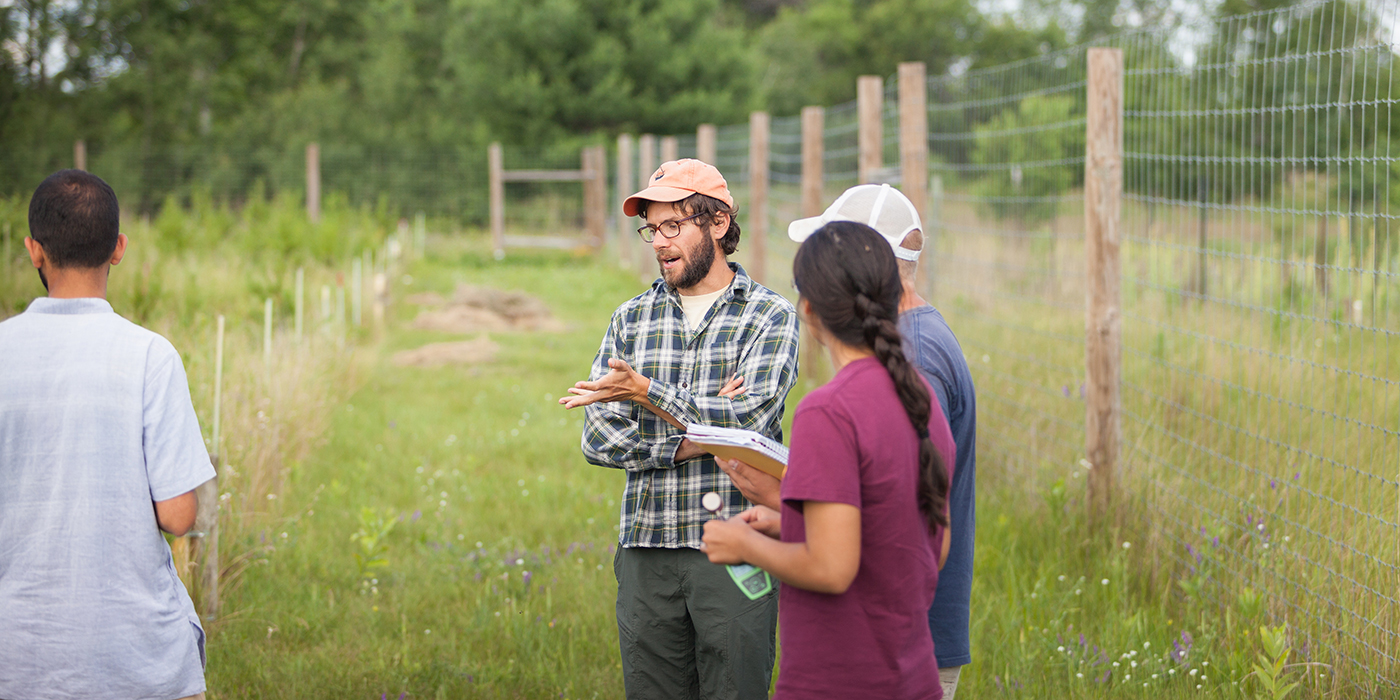
Jake Grossman talks with Allen Butterfield and ZhaaZhaa Greensky in the field at Cedar Creek Ecosystem Reserve.
"It’s about inviting culture not responding to a preconceived notion of culture."
ZhaaZhaa Greensky and Allen Butterfield spent ten weeks this summer immersed in ecology research at Cedar Creek Ecosystem Science Reserve. Their experience was, in many ways, like that of other undergraduates doing field research—with one important difference. They are part of a NASA-funded program for Native American students that focuses on the intersection of climate change and traditional ways of life.
Working with Ecology, Evolution and Behavior graduate students Jake Grossman (advised by Jeannine Cavender-Bares) and Siddharth Iyengar (advised by Elizabeth Borer and Eric Seabloom), Butterfield, a junior at the University of Minnesota, Duluth, gathered data on leaf chemistry and herbivory. Greensky pursued a project on the ecophysiology of paper birch. The North Central Michigan College sophomore’s interest in the slender-trunked trees with their luminous white bark was scientific and cultural. "Paper birch are very important to the Anishanabe people," she says.
Both Greensky and Butterfield are Ojibwe. Both grew up near Grand Rapids. And both attended Gidakiimanaaniwigamig STEM Camps organized by Dr. Holly Peloran and Dr. Wren Walker Robbins, director of Changing Communities Consulting, a firm that helps to build effective outreach programs in Native communities. The organizations partnered with Cedar Creek and Fond du Lac Tribal and Community College to apply for the grant.
Inviting culture in
"Having Native students come to U of M to do research is a transformative experience, especially if it affirms who they are,” says Walker Robbins. Making STEM programs more accessible to underrepresented and underserved communities isn’t enough to move the needle on the significant disparity in the number of Native American students entering STEM fields and pursuing degrees in the sciences, which Walker Robbins attributes to a science culture that forces them to ignore and devalue their culture and identity. Building cultural competency among today’s scientists and educators is key.
Stepping into another culture is a vital part of that process. “The pathway to cultural competency involves taking a journey across culture, to immerse yourself in a cultural discourse quite different from your own, and all of a sudden you have a window onto your own culture,” Walker Robbins says.
Building cultural competence
Iyengar and Grossman prepared for their roles as mentors and camp leaders (they hosted about 20 middle school students for a weeklong camp this summer) by attending “Gidaa” camps in Cloquet, MN over the winter, listening to Ojibwe stories about the natural world, and gaining a better understanding of the contemporary cultural context in which those stories are told; a context that includes changing climate and environment.
“This isn’t just a research opportunity where students just come to do a science project, it’s one in which we facilitate integration of that with the world they are coming from," says Grossman. Part of that is acknowledging the diversity in how an individual relate to their culture, he say. Robbins echoes that sentiment. "It’s about inviting culture not responding to a preconceived notion of culture."
Butterfield returned to Duluth for fall semester and Greensky is back at school in Michigan with an eye to majoring in biochemistry. Of her time at Cedar Creek she says: “The program gave me the opportunity to experience both research and my culture, and think about ways they can be combined as opposed to past views where they are two completely different worlds.”